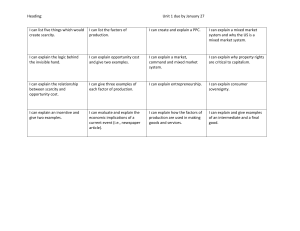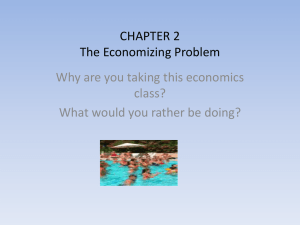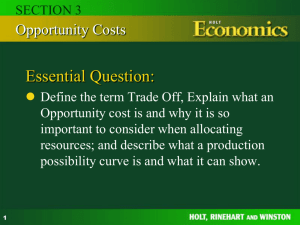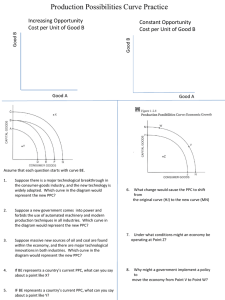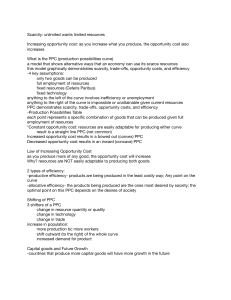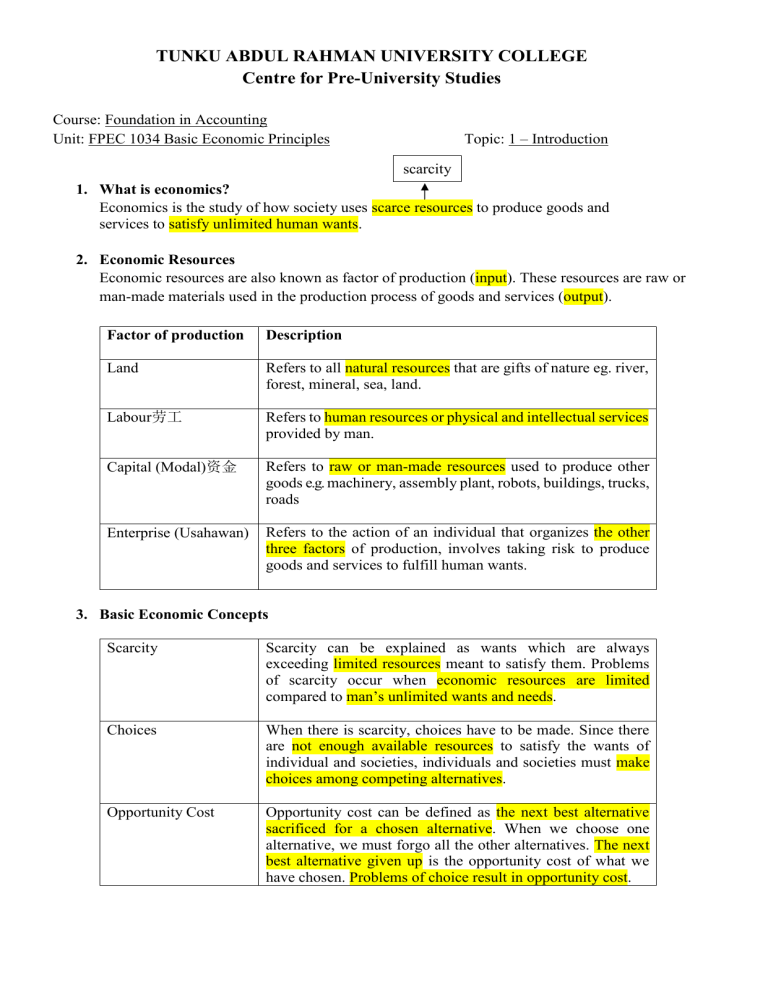
TUNKU ABDUL RAHMAN UNIVERSITY COLLEGE Centre for Pre-University Studies Course: Foundation in Accounting Unit: FPEC 1034 Basic Economic Principles Topic: 1 – Introduction scarcity 1. What is economics? Economics is the study of how society uses scarce resources to produce goods and services to satisfy unlimited human wants. 2. Economic Resources Economic resources are also known as factor of production (input). These resources are raw or man-made materials used in the production process of goods and services (output). Factor of production Description Land Refers to all natural resources that are gifts of nature eg. river, forest, mineral, sea, land. Labour劳工 Refers to human resources or physical and intellectual services provided by man. Capital (Modal)资金 Refers to raw or man-made resources used to produce other goods e.g. machinery, assembly plant, robots, buildings, trucks, roads Enterprise (Usahawan) Refers to the action of an individual that organizes the other three factors of production, involves taking risk to produce goods and services to fulfill human wants. 3. Basic Economic Concepts Scarcity Scarcity can be explained as wants which are always exceeding limited resources meant to satisfy them. Problems of scarcity occur when economic resources are limited compared to man’s unlimited wants and needs. Choices When there is scarcity, choices have to be made. Since there are not enough available resources to satisfy the wants of individual and societies, individuals and societies must make choices among competing alternatives. Opportunity Cost Opportunity cost can be defined as the next best alternative sacrificed for a chosen alternative. When we choose one alternative, we must forgo all the other alternatives. The next best alternative given up is the opportunity cost of what we 1 of choice result in opportunity cost. have chosen. Problems Example 1: David has RM 5 and he would like to buy two things: a book and a pen which cost RM5 each (unlimited wants but limited resources). David has to choose either to purchase a book or a pen which would satisfy his needs (choices). If David chooses the book, then the pen is the opportunity cost because it is the next best alternatives which he has to forgo. Example 2: Raymond hopes to be a rock star, and he would need a large amount of income to set up his band. By doing so, he must forfeit a large amount of income to attend college and the opportunity cost is the inability to further his studies. 4. Basic Economic Problems What and how much to produce? The problem of scarcity restricts our ability to produce everything we want during a given period, so the choice of producing more of one good, requires producing less of another good. This will lead to opportunity cost. How to produce? Society has to decide how to combine technology and the scarce resources to produce goods and services. The production technique could be labour-intensive or capital-intensive. For whom to produce? Society must know how to distribute the produced goods and services. This is usually determined by income distribution. Those in the higher income group will get more and better quality goods as compared to the lower income group. 5. Types of goods Free goods - can be defined as goods with zero opportunity cost. They are abundant in supply (unlimited in quantity) and are considered gifts of nature. There is no price to be paid for these goods. Example: air, sunlight, rain-water, snow Economic goods - can be defined as goods where opportunity cost is involved. There is a price to be paid for these goods. It has the characteristics of excludable and involves rivalry. They are scarce in supply. Example: television, clothing, raw materials 2 Private goods - A private good or service has three main characteristics: (i) Excludability排他性: Consumers of private goods can be excluded from consuming the product if they are not willing or able to pay for it. For example - a ticket to the cinema or a meal in a restaurant. Another good example is the increasing use of “pay-per-view” as a means of extracting payment from people wanting to watch exclusive coverage of sporting events on television or the use of subscription-based services on the internet. (ii) Rivalry竞争: With a private good, one person's consumption of a product reduces the amount left for others to consume - because scarce resources are used up in producing and supplying the good or service. Example: If you order the last piece of pizza, then that pizza is no longer available to someone else. Likewise driving your car on a road uses up road space that is no longer available at that time to another motorist. (iii)Rejectability: Private goods and services can be rejected - if you don't like the meal on the college menu, you can use your money to buy something else at somewhere else. You can also choose not to travel by bus or you can choose instead to travelby taxi. Capital goods - goods that can be used to produce other goods. Example: machinery, factories Consumption goods - Goods that are consumed by people and give immediate satisfaction. Consumption goods can satisfy human wants. Example: clothing, shoes, food, health services Public goods - can be defined as goods and services provided by the government for communal use. Nobody is prohibited from using these goods and services, regardless whether he is a taxpayer or not. Public goods have the characteristic of non –excludability which means nobody is prevented from using them and non-rivalry which means the consumption by one person will not reduce the availability to others. Example: street lighting, flood control systems, national defence services. Merit goods - can be defined as goods and services that are beneficial to consumers. Merit good are those goods and services that the government feel that people will under-consume, and which ought to be subsidized or provided free at the point of use. Both the public and private sector provide merit goods & services. Consumption of merit goods is widely believed to generate positive externality effects - where the social benefit from consumption exceeds the private benefit. 3 A merit good is a product that society values and judges that everyone should have regardless of whether an individual wants them. In this sense, the government (or state) is acting paternally in providing merit goods and services. They believe that merit goods are underconsumed as individuals have imperfect information about the benefits that can be derived from these goods. Examples of merit goods include health services, education, work training programmes and public libraries. The government often provides merit goods “free at the point of use”, financed through taxation. Examples include primary health care available to people through the National Health Service and books borrowed from local authority libraries. Demerit goods - generate negative externality effects. Example: alcohol drug, taxes(high) 6. Economic System An economic system is a complex network of individuals, organizations and institutions in a society whose decision determine the ways in which the scarce resources are used to produce goods and services and the manner in which these outputs are distributed for consumption. There are three types of economic systems: The command economy It is also known as the planned economy(socialist). Everything is controlled by the government and the three basic economic problems like what and how much to produce, how to produce and for whom to produce will be solved by the government. Features: All factors of production are owned by the state/government. Centralized planning - all economic activities are decided and controlled by the central planning authority. Choice – individual has little choice (low consumer sovereignty主权) as the type of goods produced is determined by the government. There is little incentive for enterprise and innovation. Inefficient allocation of resources – tend to have shortages of certain goods and services and surplus of others. This represents a waste of resources. Tendency to exist large bureaucratic structure where there is a need to coordinate and control the system to ensure that various units perform their assigned tasks. Such huge structures tend to create problems in communication and coordination. Income and growth – failed to match growth performances of the other 2 economic systems. Example: North Korea 4 The market economy It is also known as the capitalist, laissez-faire economy. There is no government intervention and all economic activities are carried out by the private sector or individuals. Features: All factors of production are privately owned by individuals, firms and institutions. Freedom of choice – individuals have the right to own, control and dispose of their resources in any way they want. Consumers are free to choose goods and services that satisfy them. Consumers are provided with a wide range of choice in terms of price and quality. Self-interest as the dominating motive - consumers attempt to maximize satisfaction, producers attempt to maximize profit. Consumers indicate to the producer what they desire by the price that they are willing to pay. The higher the price, the higher level of profit to the producers. Resources are channeled to produce the goods that individuals demand. In order to maximize profit, the producers must maximize revenue and minimize cost. The producer may decide to use either labour- intensive method or capital-intensive method. Goods will be produced for those consumers who are willing to pay and able to pay. Usually, the amount of goods in the market is insufficient to meet the demand of all who are willing to pay. Competition will drive up price eliminating those who are unable or unwilling to pay. Thus, product price will ration out scarce goods to those who can afford to pay the price. The economy achieves economic efficiency in allocating resources. Self-interest encourages the use of resources in line with consumers’ preferences. The producers produce goods according to the wants of society. There is minimum wastage in terms of producing goods that are unwanted. There will be automatic response to change and there is no need for costly and complex bureaucracies to coordinate plans. The producers will respond to the change in the demand of the goods and reallocate resources accordingly. High economic growth can be achieved as the high profit is the reward thus incentive to increase productivity. However, there will be inequality in income distribution due to the non-intervention by the government. A wide gap between the poor and the rich exists. The rich who are normally the producers will get richer while the poor will get poorer. The economy fails to provide public goods like street lighting 5 The mixed economy Both the public sector and private sector work hand in hand to ensure the economic growth of the country. Features: Resources are partly owned by private individuals and partly by the state/government. The main motivation of the private producers is profit while the state attempts to considerthe welfare of the community. The private sector conducts businesses in the economy andthe government encourages the private sector by providing them with infrastructures like electricity, water, highways and ports. The role of the public sector is not to compete with the private sector but to complementthe private sector by providing assistance and infrastructures to speed up economic growth. The government will create a framework of rules to supplement and modify the price system to achieve high economic growth and to stabilize the economy. The government will also control the existence of monopolies. A monopolist is a single seller of a particular good that usually reduces output to keep prices of its goods high. In this way, the consumer is exploited when needed to pay a high price for the goods and thegovernment intervenes to regulate the power of monopolies. There will be the redistribution of income by the government to achieve a more equitable distribution. The government may impose a progressive tax system where higher income earners are taxed more than the lower income earners and the poor are given assistance in the form of subsidies. In this way the gap between the poor and rich is narrowed down. Example: Malaysia, Singapore 7. Production Possibility Curve(Frontier) It shows the various possible combinations of goods and services that the economy can produce given a limited amount of resources and the most efficient technique of production. Assumptions of Production Possibilities Curve: A country produces only two goods, eg: good X and good Y Fixed quantity and quality of resources Level of technology is fixed or stagnant The economy is operating at full employment and has achieved maximum efficiency. 6 Diagram Illustration Point A on the PPC indicates that the economy would allocate all its resources to provide good Y only and zero units of Good X. At the other extreme, point D indicates that the economy would allocate all its resources to provide good X only and zero units of Good Y. Points A, B, C and D indicate that the economy has achieved full employment (on the curve), hence usesall the resources available in production. The economy can also produce any combinations inside the curve, but this would mean that some resources are unemployed or inefficient method of production is being used. Eg. Point F. The economy could produce more of both goods by moving to a point such as point C. If the point inside PPC such as point F moves towards the PPC eg point C, it is referred as an increase in economic activities. Point outside the PPC such as G is not attainable with the present production capacity. The factors which enable point G to be reached: a) b) c) d) e) An increase or advancement in technology Increase in labour force Increase in population Increase in resources example raw materials Specialization and division of labour 7 8. a) Production possibility curve with increasing opportunity cost The production possibility curve displays a bowed-out shape due to the increasingopportunity cost. The opportunity cost increases as production of one output expands. Table and Diagram calculation Points on PPC A B C D E Good Y (units) (Y-axis) 15 13 10 6 0 Good X (units) (X-axis) 1 2 3 4 5 The production possibility curve displays a bowed-out shape (the shape is concaved to the origin) due to the increasing opportunity cost. The opportunity cost increases as production of one output expands. This means that to increase one unit of a good, the number of units of the other good that needs to be forgone or sacrificed increase at each combination of production. For example to increase 1 unit of Good X from 1 to 2, the economy has to sacrifice 2 unit of Good Y(15 – 13) and to increase 1 more unit of Good X from 2 to 3, the economy has to sacrifice 3 units of Good Y(13 – 10). This shows that the opportunity cost is increasing. 8 b) Production possibility curve with constant opportunity cost The production possibility curve displays a downward sloping straight line curve due to the constant opportunity cost. The opportunity cost remains the same as production of output expands. Table and Diagram Points on PPC A B C D E Good Y (units) (Y-axis) 50 40 30 20 10 Good X (units) (X-axis) 0 1 2 3 4 The production of an additional 1 unit of Good X as shown in the movement from point A to point B involves forgoing the production of 10 (50 – 40) units of Good Y. From point B to C involves forgoing 10 units of good Y as well. When there is additional production of Good X, an equal number of Good Y needs to be sacrificed thus this is law of constant opportunity cost. 9 9. Economic growth (↑ production) The outward shift of the PPC is referred as economic growth, the country’s capacity to produce goods increases. This outward shift permits the economy to produce greater quantities of output. Technology advances or growth in the resource base enables the PPCto shift outwards. Diagram The production possibility curve shifts outwards (shifts to the right) from PPC to PPC1 indicating economic growth. This means that the economy (country) is now able to produce more goods and services. At point A, the economy produces 10 units of Good X and 10 units of Good Y. With economic growth, the economy is able to produce more of Good X and Good Y. This is shown bypoint B where the economy produces 18 units of Good X and 15 units of Good Y. 10. Economic Decline (↓ production) Production possibilities of a country could have declined where the PPC shifts inward: Factors that lead to an economic decline are: a) b) c) d) Depletion of natural resources Natural disaster War Decrease in population 10 Diagram The production possibility curve shifts inwards (shifts to the left) from PPC to PPC1 indicating economic decline. This means that the economy (country) is now able to produce less (fewer) goods and services compared to before. At point A, the economy produces 8 units of Good X and 7 units of Good Y. With economic decline, the economy is able to produce fewer of Good X and Good Y. This is shown by point B where the economy produces 5 units of Good X and 5 units of Good Y. 11



